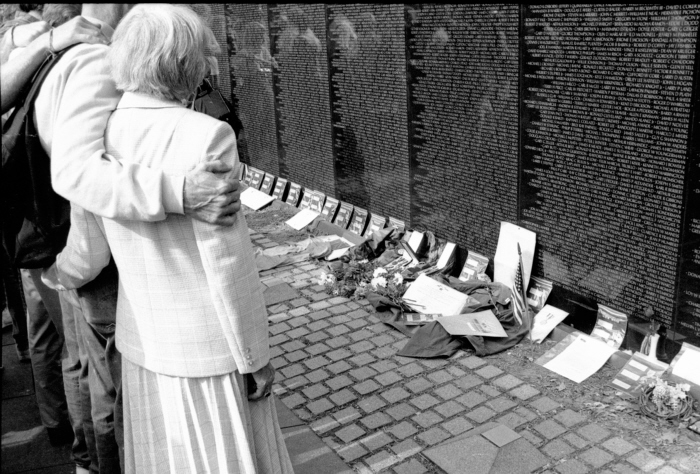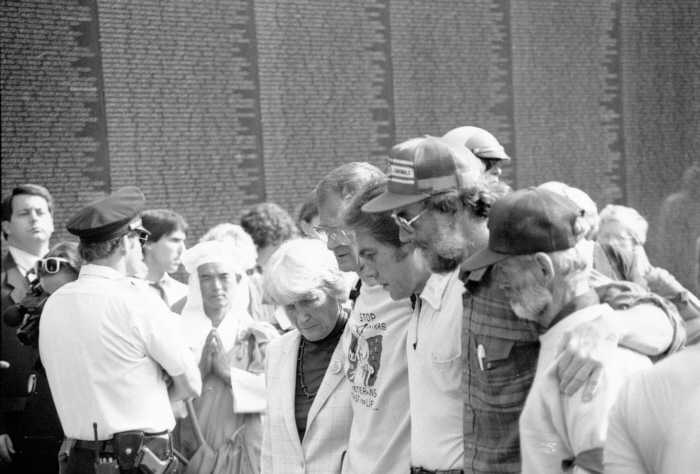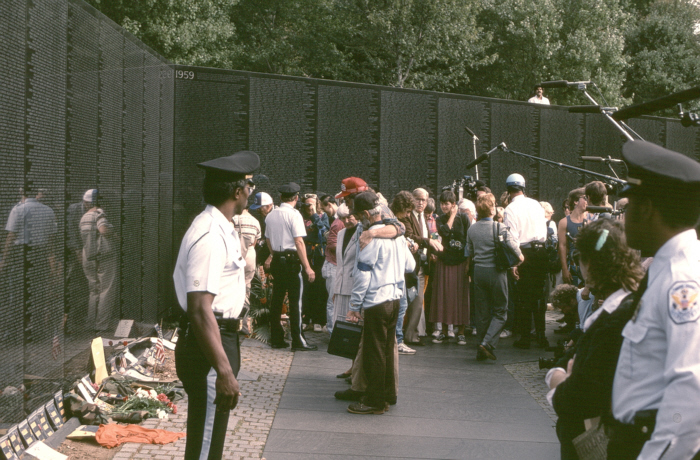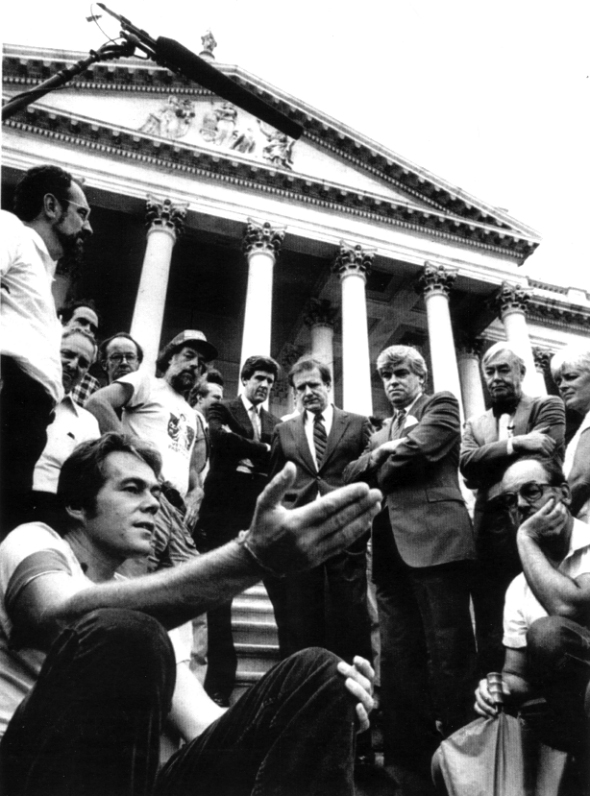
Photo: Rick Reinhard. Decorated Vietnam veteran George Mizo (lower left), sits on the east steps of U.S. Capitol in Washington, D.C., October 3, 1986, on the 33rd day of a water-only, open-ended hunger strike, the "Veterans Fast For Life" (VFFL), explaining the fast (protesting Reagan's illegal aid[1] to fund Contra paramilitary activities seeking to overthrow the sovereign Sandinista government in Nicaragua) to U.S. Democratic senators. Onlookers include (from left) fellow faster Vietnam veteran S. Brian Willson (wearing baseball hat), John Kerry Mass.), Donald Riegle (Mich.), Christopher Dodd (Conn.) and Daniel Patrick Moynihan (N.Y.). [Office Of The Americas Executive Director Theresa Bonpane stands next to Senator Moynihan — B.B.] Vietnam veteran Charlie Liteky, recipient of the Congressional Medal of Honor, and World War II veteran Duncan Murphy were the other two participating fasters not shown in this photo.
The veterans believed that the President's explicit policy of directing the contra terrorists in Nicaragua to commit wanton murder and destruction, enabled by appropriations passed by a majority of members of the U.S. Senate and House of Representatives, amounted to grotesque, unconscionable violent behavior in violation of both U.S. Constitutional and international law, and the egregious breach of the human rights of virtually all Nicaraguan citizens. The veterans believed that the President was clearly vulnerable to Constitutional impeachment, and that all members of the Senate and House of Representatives should have been subjected to criminal prosecution under international law as well, whether they were re-elected or not.
[1]The International Court of Justice (ICJ/World Court) formally judged on June 27,1986 that the United States had intervened by "training, equipping, financing and supplying the contra forces or otherwise encouraging, supporting and aiding military and paramilitary activities in and against" the Republic of Nicaragua, had used "force" by "certain attacks on Nicaraguan territory," and violated "sovereignty" by "authorizing overflights of Nicaraguan territory" while interrupting "peaceful maritime commerce." The Court judged that the United States was "under a duty immediately to cease and refrain from all such acts" (of what were in substance grotesque acts of terrorism) and "to make reparation to the Republic of Nicaragua for all injury caused to Nicaragua by the breaches of obligations under customary international law enumerated" herein. SEE Military and Paramilitary activities in and against Nicaragua (Nicaragua v. United States of America), Merits, Judgment 27 June 1986 (I.C.J. Reports 1986, p. 14).
NOTE: President Truman ratified the Charter of the United Nations and the Statute of the International Court of Justice on August 8,1945, two days after dropping the atomic bomb on Hiroshima and one day before dropping a similar one on Nagasaki. President Reagan quickly dismissed with contempt the judgment of the ICJ in the Nicaragua case. The contra terrorist activities continued for 4 more years. No reparations were ever granted to Nicaragua. The fast ended at 47 days after thousands of people, through letters, phone calls, and personal visits, shared hundreds of concurrent solidarity actions protesting U.S. terrorist policies in Central America. Later the four fasters were shocked to learn the FBI had placed them on the domestic terrorist suspect list, citing numerous protest actions as part of a "conspiracy" to "coerce" alteration of U.S. policies. One Senator, Rudman (R-NH), compared the fasting veterans to Middle Eastern terrorists.
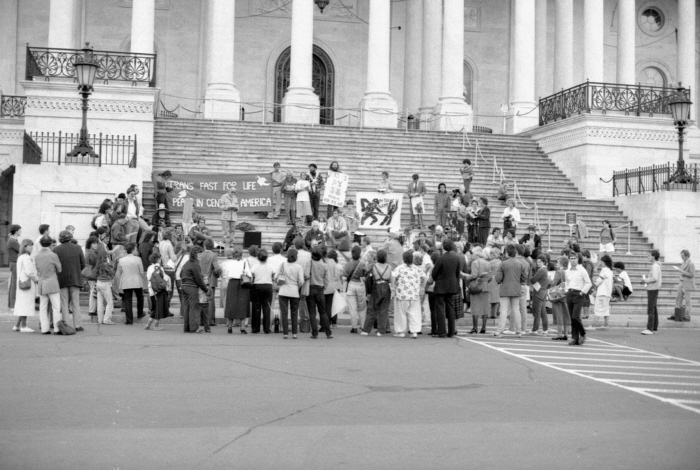 A typical view from the street. Day 38 of the fast.
A typical view from the street. Day 38 of the fast.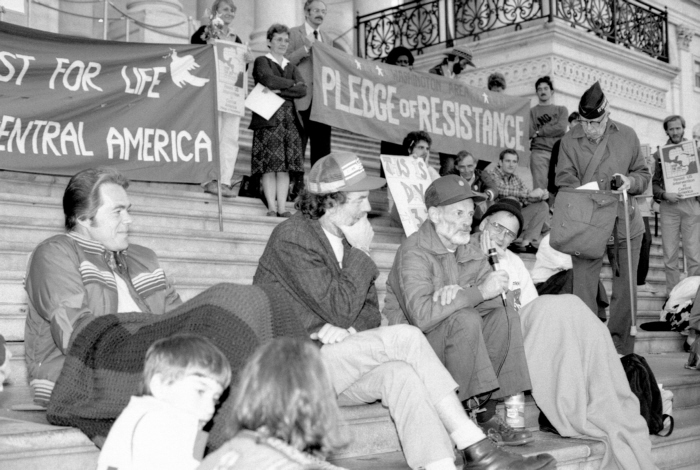 From left to right: George Mizo, Brian Willson, Duncan Murphy, and Charles Liteky. Here Duncan Murphy holds the mike. Judging by the hints of smiles from the other vets, he must be saying something funny.
From left to right: George Mizo, Brian Willson, Duncan Murphy, and Charles Liteky. Here Duncan Murphy holds the mike. Judging by the hints of smiles from the other vets, he must be saying something funny.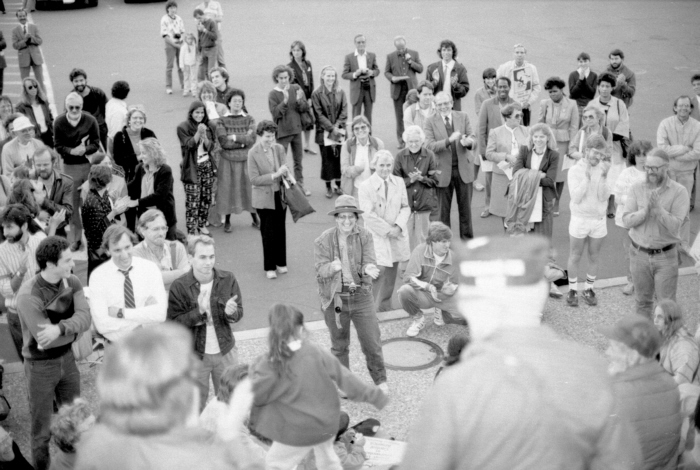 The crowd agrees. Who says that peace activists don't have a sense of humor.
The crowd agrees. Who says that peace activists don't have a sense of humor.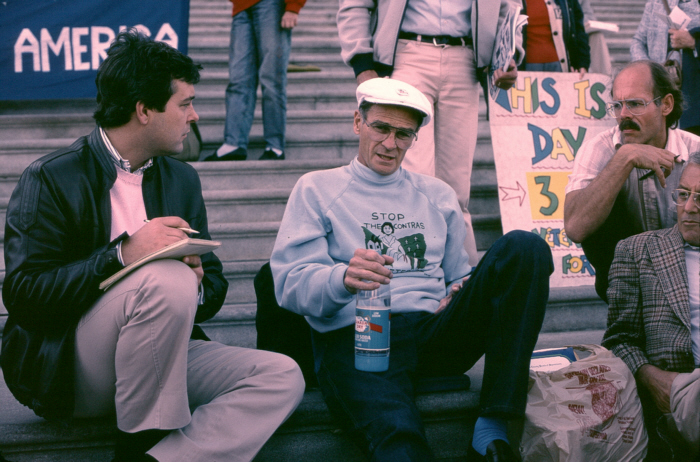 One of the hundreds of the vets' supporters takes notes.
One of the hundreds of the vets' supporters takes notes.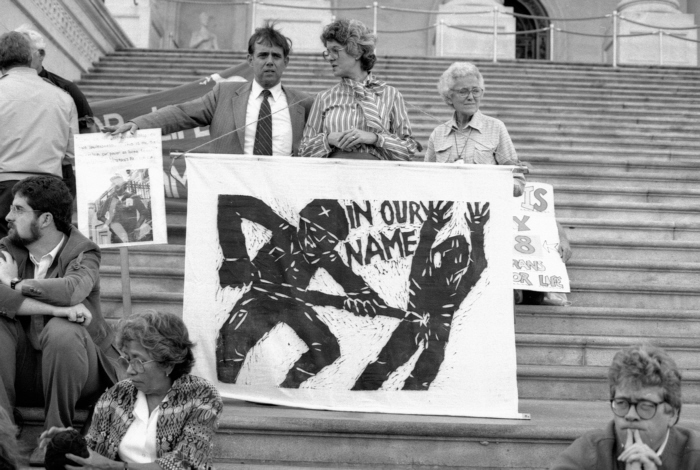 The victim being bayonetted here, "in our name," by a U.S. surrogate is certainly a poor campesino who dared to try to organize for better wages and better living conditions. These poor Central Americans were of course labeled "communists," which justified all manner of atrocities committed against them.
The victim being bayonetted here, "in our name," by a U.S. surrogate is certainly a poor campesino who dared to try to organize for better wages and better living conditions. These poor Central Americans were of course labeled "communists," which justified all manner of atrocities committed against them.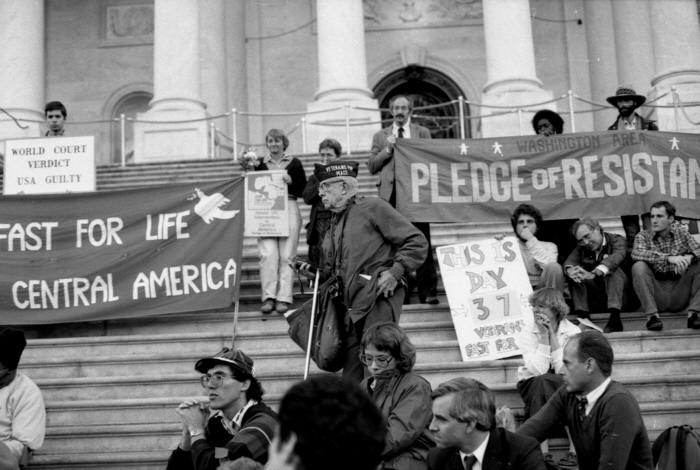 Another WWII veteran, wearing a Veterans for Peace cap.
Another WWII veteran, wearing a Veterans for Peace cap.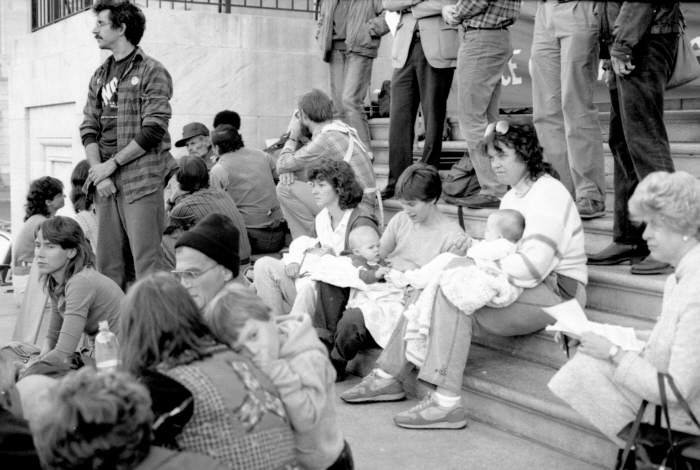 Moms start their babies off on the right foot toward becoming peace advocates.
Moms start their babies off on the right foot toward becoming peace advocates.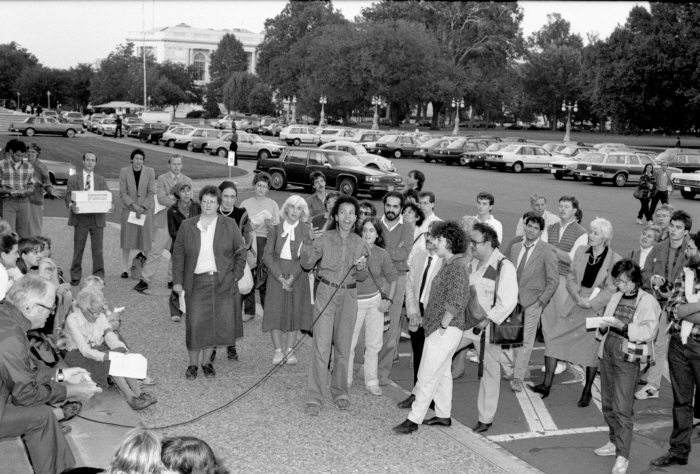 Bonnie speaks with another protester; upper left, behind the man in the checked shirt. I don't remember what the young man with the microphone was saying.
Bonnie speaks with another protester; upper left, behind the man in the checked shirt. I don't remember what the young man with the microphone was saying.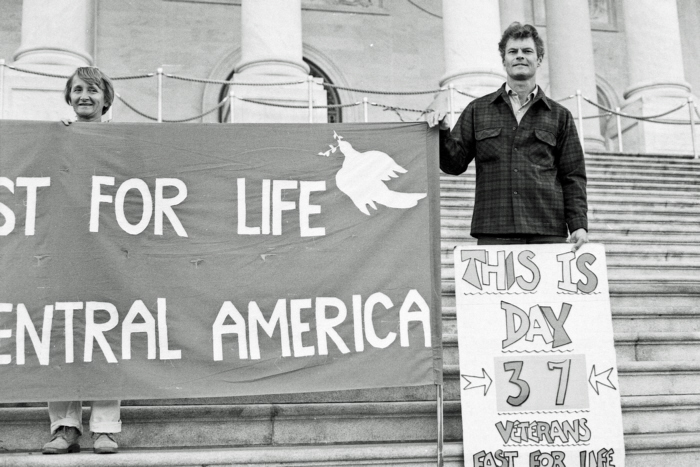 Yours truly holds the banner. It was probably on this day that I noticed House speaker Tip O'Neill exit a limousine that had pulled up alongside the left wall of the steps. O'Neill went directly to an entrance not visible to us without so much as a glance at the vets on the steps. This irritated me greatly.
Yours truly holds the banner. It was probably on this day that I noticed House speaker Tip O'Neill exit a limousine that had pulled up alongside the left wall of the steps. O'Neill went directly to an entrance not visible to us without so much as a glance at the vets on the steps. This irritated me greatly.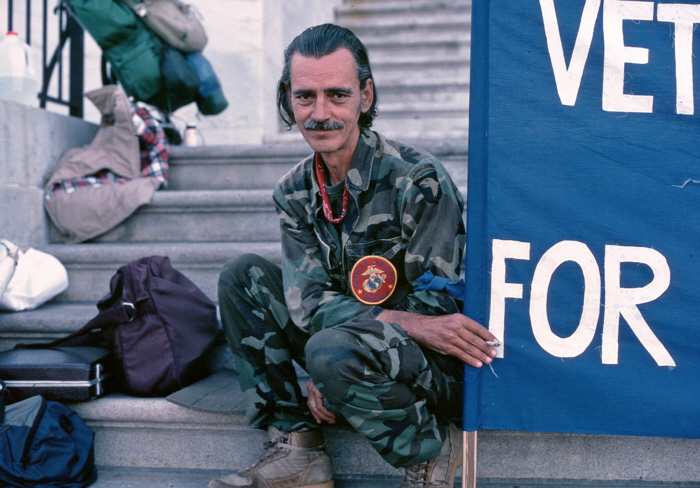 This veteran says it all without saying a word.
This veteran says it all without saying a word.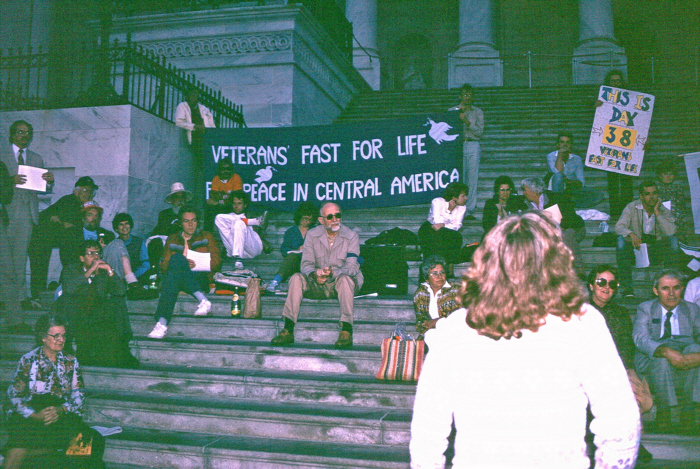 Evening vigil.
Evening vigil.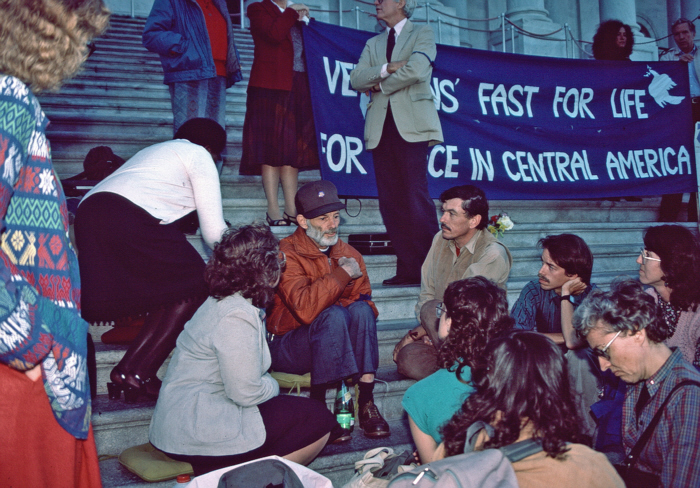 Duncan Murphy.
Duncan Murphy.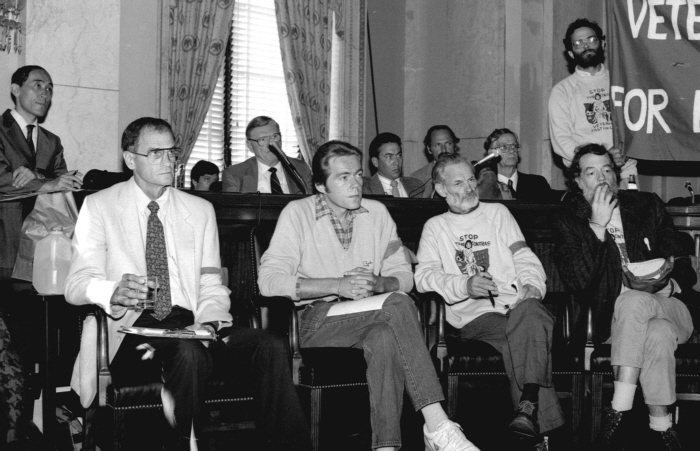 October 7th. The vets wait through introductory remarks by a series of Congressmen and other officials at a press conference. While I was taking the pictures shown below, Bonnie had a nice conversation with Senator John Kerry.
October 7th. The vets wait through introductory remarks by a series of Congressmen and other officials at a press conference. While I was taking the pictures shown below, Bonnie had a nice conversation with Senator John Kerry.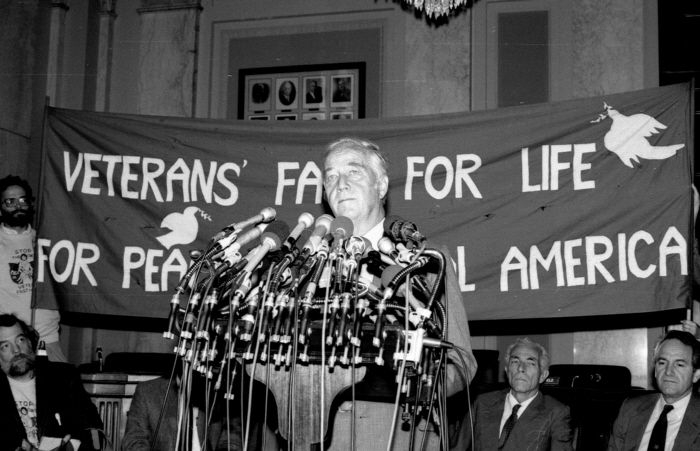 Senator Charles Mathias, R-MD. Mathias did not run for reelection in 1986.
Senator Charles Mathias, R-MD. Mathias did not run for reelection in 1986.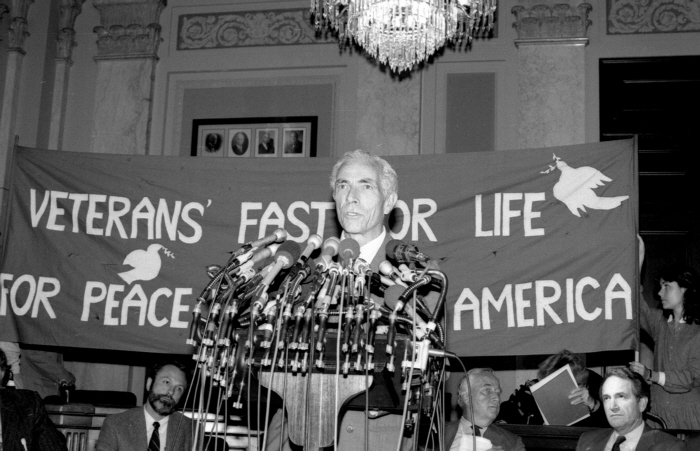 Caliborne Pell, D-Rhode Island.
Caliborne Pell, D-Rhode Island.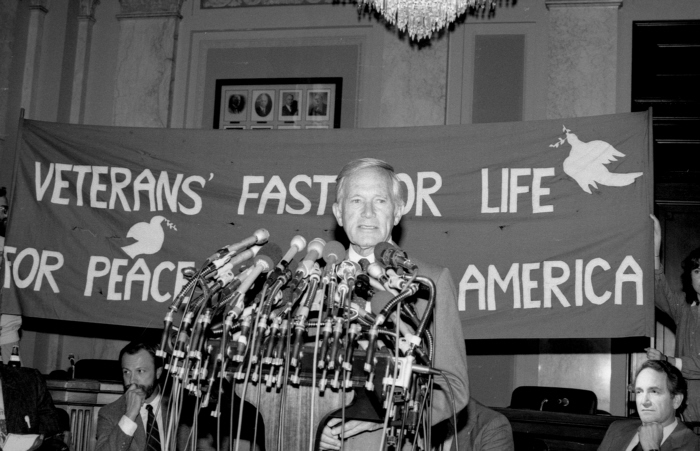 Representative William Donlon (Don) Edwards, D-San Jose, CA. As a former special agent for the FBI, Edwards became particularly interested in why the FBI designated the fasters as domestic terrorists. Brian Willson learned of this designation in 1987, after he was maimed by the weapons train at the Concord Naval Weapons Station. Perhaps the FBI had been influenced by Republican Senator Warren Rudman's infamous comparison of the protesting veterans to Middle Eastern terrorists. (RUDMAN LIKENS FASTING VETERANS TO TERRORISTS, Boston Globe, October 11, 1986)
Representative William Donlon (Don) Edwards, D-San Jose, CA. As a former special agent for the FBI, Edwards became particularly interested in why the FBI designated the fasters as domestic terrorists. Brian Willson learned of this designation in 1987, after he was maimed by the weapons train at the Concord Naval Weapons Station. Perhaps the FBI had been influenced by Republican Senator Warren Rudman's infamous comparison of the protesting veterans to Middle Eastern terrorists. (RUDMAN LIKENS FASTING VETERANS TO TERRORISTS, Boston Globe, October 11, 1986)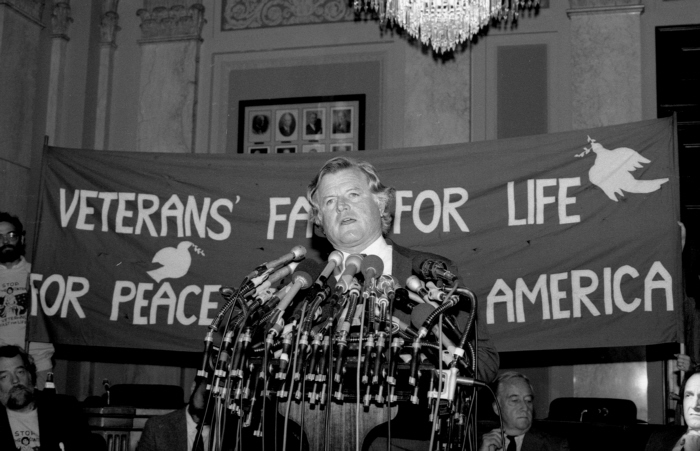 Senator Ted Kennedy, D-MA. Kennedy still represents Massachusetts in the Senate.
Senator Ted Kennedy, D-MA. Kennedy still represents Massachusetts in the Senate.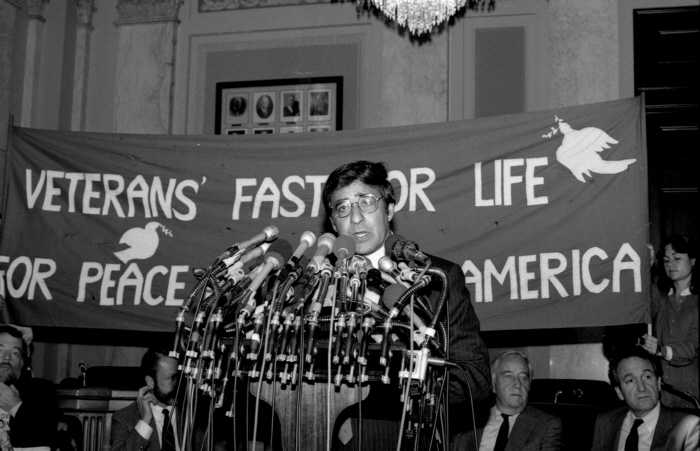 Representative Leon Panetta, D-Monterey, CA.
Representative Leon Panetta, D-Monterey, CA.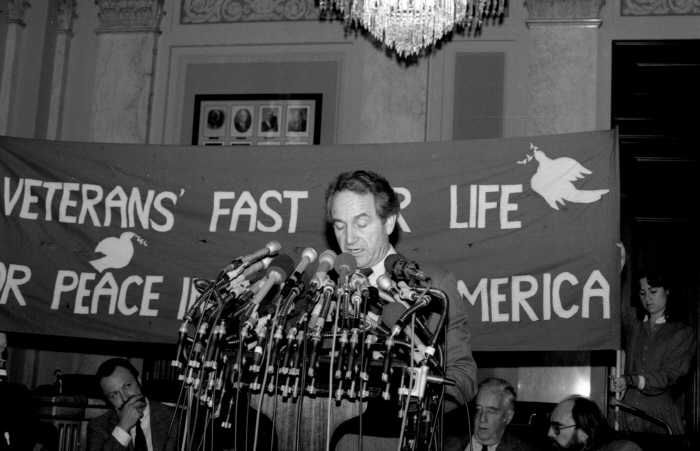 Senator Tom Harkin, D-Iowa. In 1970 Harkin was a congressional aide who helped expose the infamous "tiger cages," tiny cubicles used to hold, entire Vietnamese families suspected of being Viet Cong sympathizers. Harkin still represents Iowa in the Senate.
Senator Tom Harkin, D-Iowa. In 1970 Harkin was a congressional aide who helped expose the infamous "tiger cages," tiny cubicles used to hold, entire Vietnamese families suspected of being Viet Cong sympathizers. Harkin still represents Iowa in the Senate.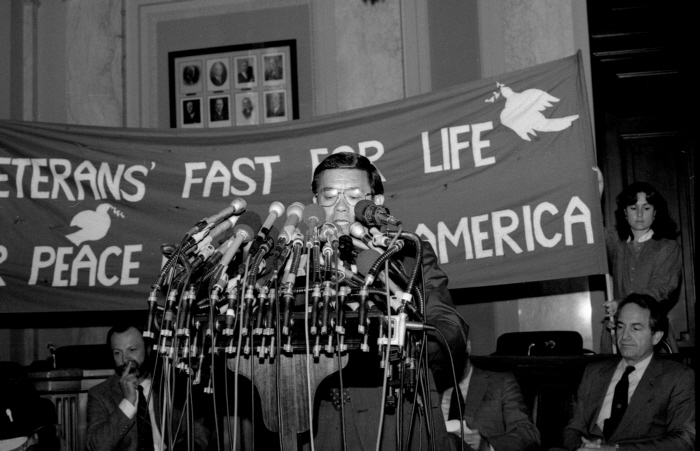 Senator Daniel Inouye speaks. Inouye is a Japanese-American WWII veteran who lost an arm after being wounded
Senator Daniel Inouye speaks. Inouye is a Japanese-American WWII veteran who lost an arm after being wounded 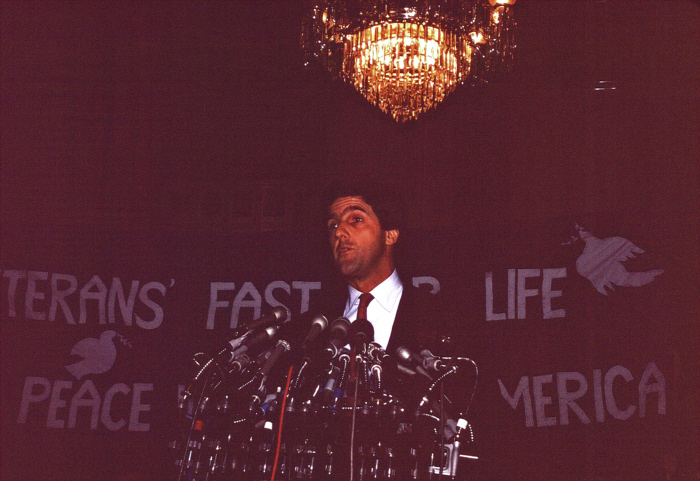 Senator John Kerry, D-MA. The flash on this camera seems to have worked poorly here. My black and white photo of the Senator is perfectly exposed, but he blinked. Many liberals and progressives think that he blinked too often in his contest with President Bush during the 2004 election. Kerry still represents Massachusetts in the Senate.
Senator John Kerry, D-MA. The flash on this camera seems to have worked poorly here. My black and white photo of the Senator is perfectly exposed, but he blinked. Many liberals and progressives think that he blinked too often in his contest with President Bush during the 2004 election. Kerry still represents Massachusetts in the Senate.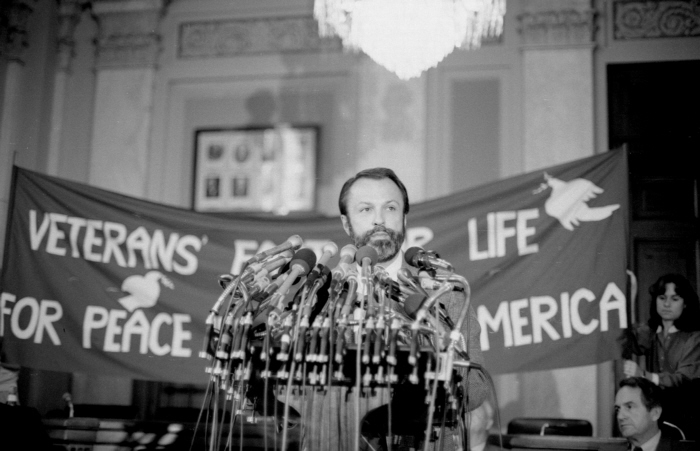 Representative David Bonior, D-Detroit, MI
Representative David Bonior, D-Detroit, MI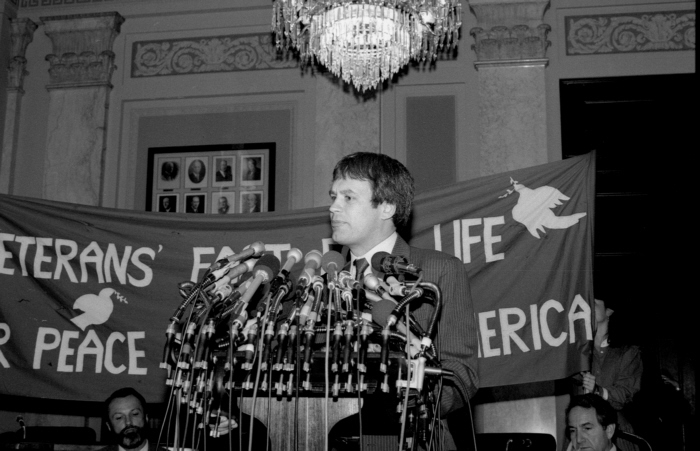 Representative Lane Evans. Democrat Evans still represents the 17th Congressional District, Illinois.
Representative Lane Evans. Democrat Evans still represents the 17th Congressional District, Illinois.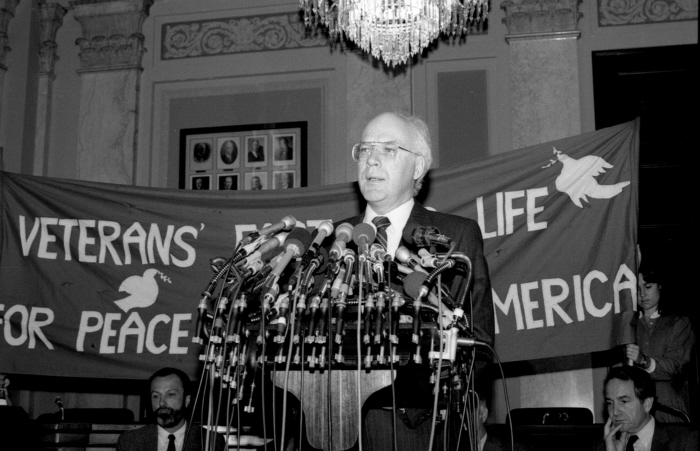 Senator Patrick Leahy. Democrat Leahy still represents the state of Vermont.
Senator Patrick Leahy. Democrat Leahy still represents the state of Vermont.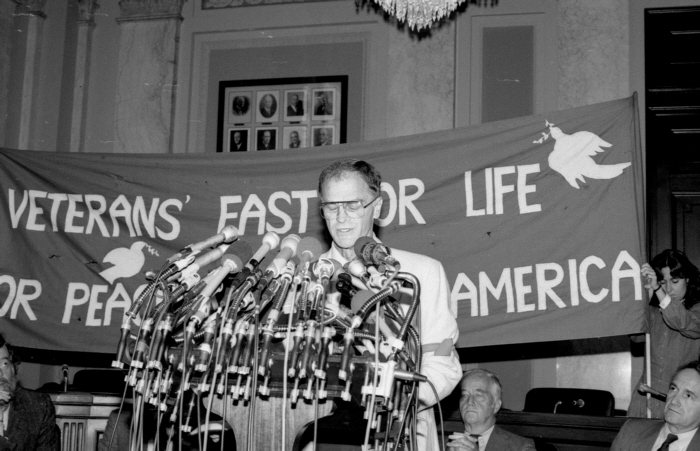 Charlie Liteky
Charlie Liteky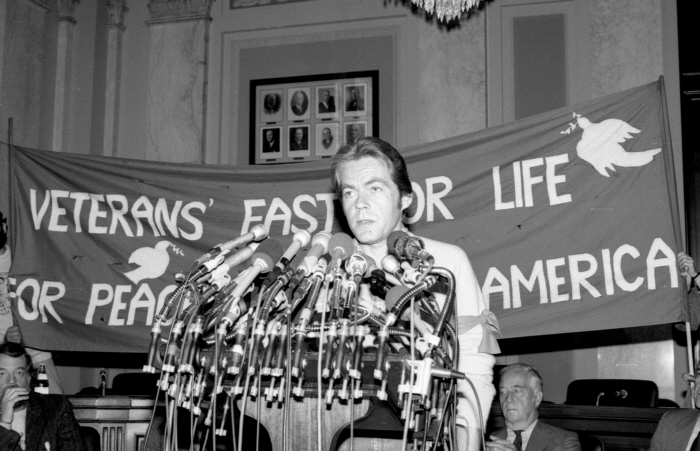 George Mizo
George Mizo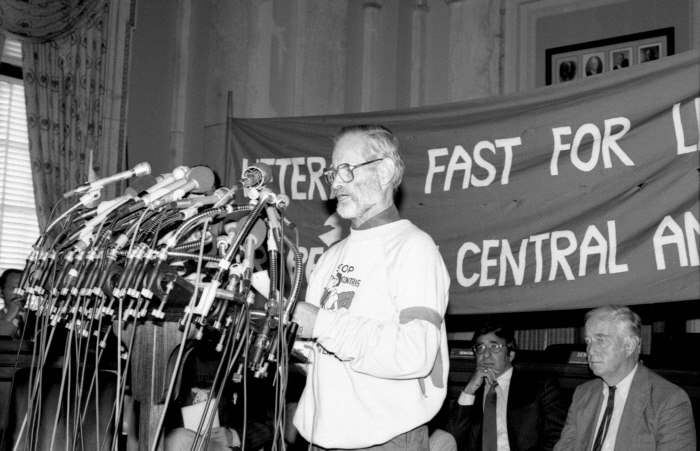 Duncan Murphy
Duncan Murphy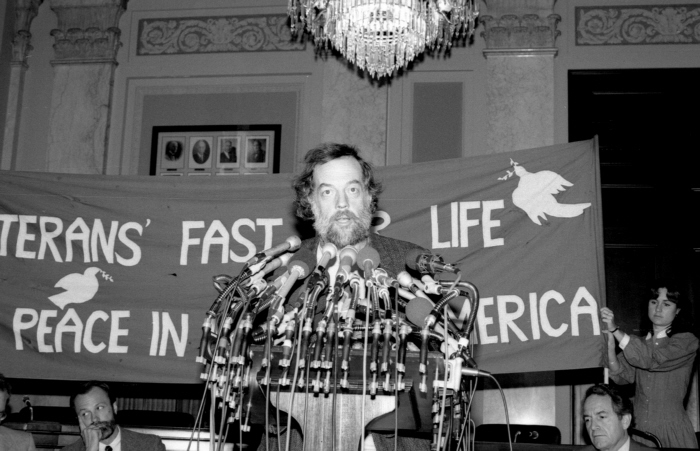 Brian Willson
Brian Willson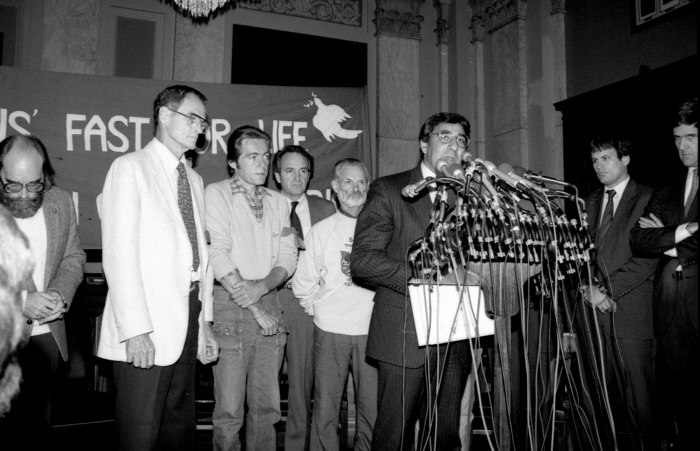 Leon Panetta concludes the press conference. Note the similarity between Senator Kerry's demeanor here and the scowls and body language shown by all the Senators in the introductory photo. Guilty consciences, perhaps?
Leon Panetta concludes the press conference. Note the similarity between Senator Kerry's demeanor here and the scowls and body language shown by all the Senators in the introductory photo. Guilty consciences, perhaps?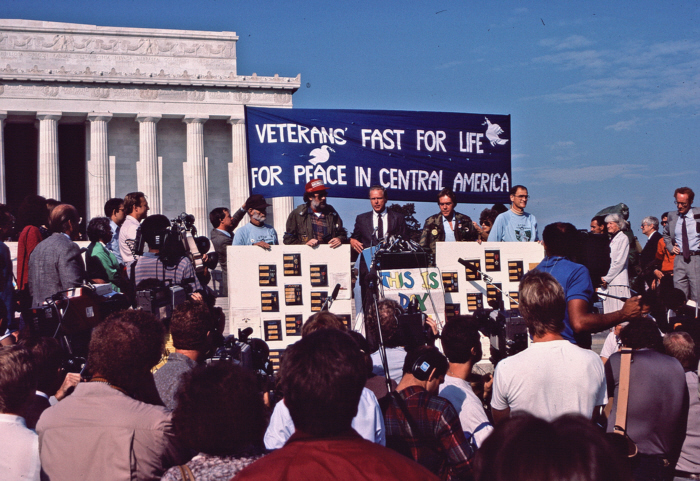 October 9. Press conference at the Lincoln Memorial. From here, the vets will walk to the Vietnam Veteran's Memorial Wall, where they will lay their medals. The woman in gray at the right will accompany them. She is Barbara Graves, at the time a Berkeley psychotherapist and Quaker. Graves received a Bronze Star as a WWII Red Cross worker setting up convalescent homes in France and England. She was the first civilian to receive a Bronze Star, awarded by citation signed by President Franklin Delano Roosevelt. (Thanks to Brian Willson for this information.)
October 9. Press conference at the Lincoln Memorial. From here, the vets will walk to the Vietnam Veteran's Memorial Wall, where they will lay their medals. The woman in gray at the right will accompany them. She is Barbara Graves, at the time a Berkeley psychotherapist and Quaker. Graves received a Bronze Star as a WWII Red Cross worker setting up convalescent homes in France and England. She was the first civilian to receive a Bronze Star, awarded by citation signed by President Franklin Delano Roosevelt. (Thanks to Brian Willson for this information.)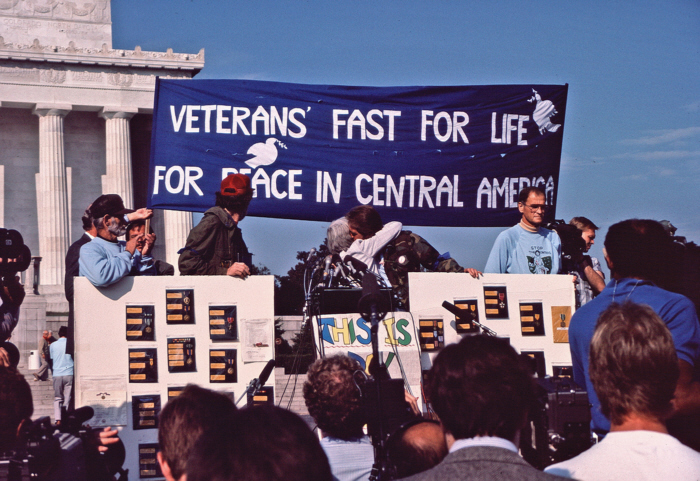
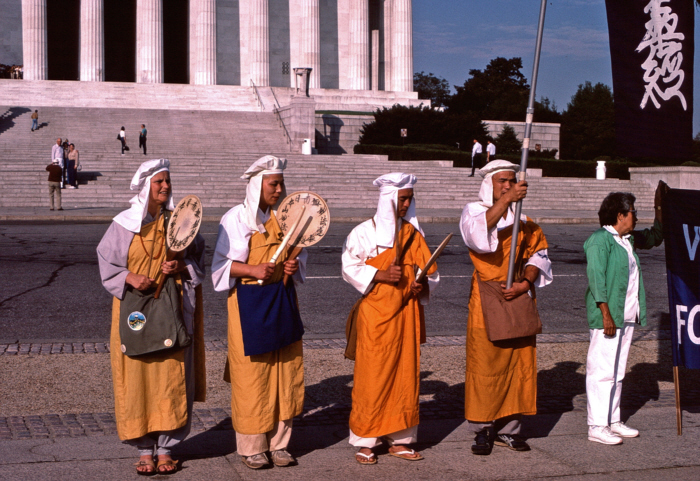 Buddhists also showed their support for the veterans. The two men on the right may have been on the
Buddhists also showed their support for the veterans. The two men on the right may have been on the 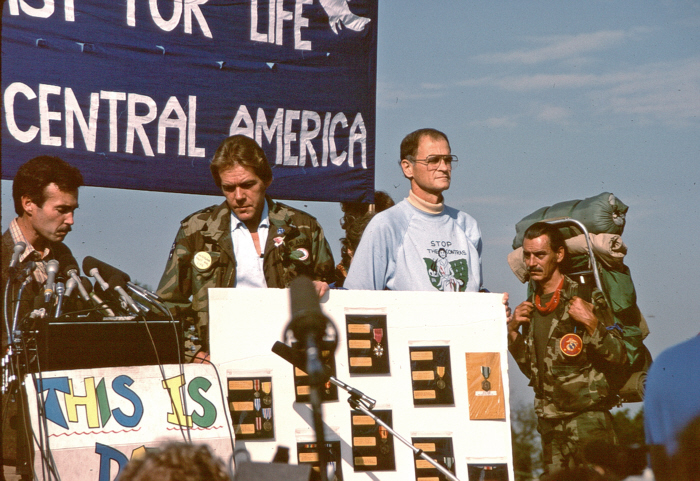
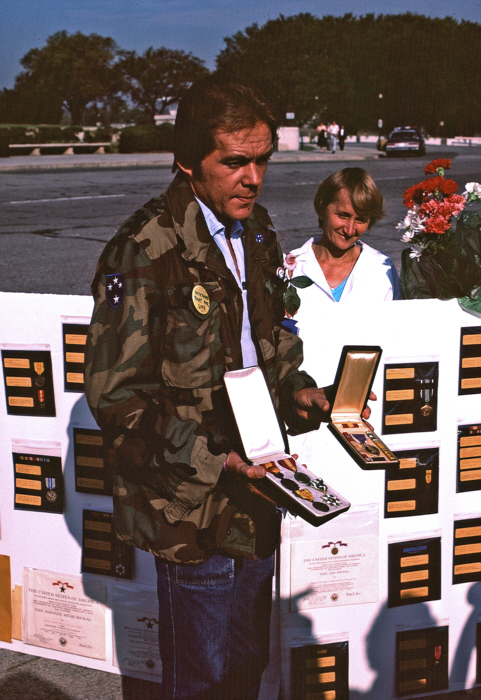
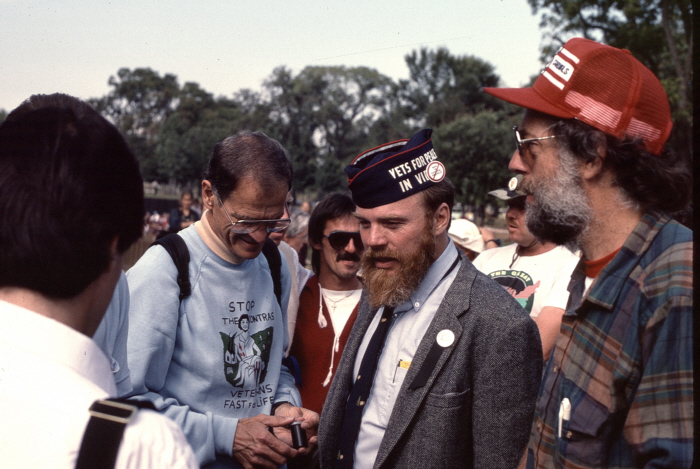 The man in the Vets for Peace cap is Stephen Fournier, a founder of Veterans for Peace.
The man in the Vets for Peace cap is Stephen Fournier, a founder of Veterans for Peace.